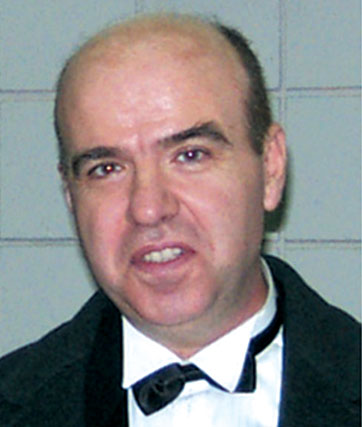Sebouh Krioghlian
Staff Writer
 With the support of Kevork Imirzian, Satenig Kassabian, Dennis Shamlian, Arsineh Khachikian, and Barlow Der Mugrdechian; Iakovos Kolanian, a critically acclaimed Armenian-Greek classical guitarist gave a benefit concert on March 5 for the Armenian Community School of Fresno and the Armenian Studies Program at Fresno State.
With the support of Kevork Imirzian, Satenig Kassabian, Dennis Shamlian, Arsineh Khachikian, and Barlow Der Mugrdechian; Iakovos Kolanian, a critically acclaimed Armenian-Greek classical guitarist gave a benefit concert on March 5 for the Armenian Community School of Fresno and the Armenian Studies Program at Fresno State.
Kolanian, born in Greece in 1960, started to study classical guitar at the age of 13 and graduated in 1985 with the top award and special honor for exceptional performance from the National Conservatory of Athens. Since that time, he has toured Europe, Asia and Latin America, and has regularly taken part in important international festivals by giving individual recitals, or performing as a soloist with symphonic orchestras and ensembles of chamber music.
Some of the orchestras Kolanian has performed with include the Athens State Orchestra, Thessalonica State Orchestra, Symphonic Orchestra of Greek Broadcasting Corporation (ERT), the Camerata Orchestra of Athens, and Armenian Philharmonic Orchestra. He has also been regularly featured in well-known television and radio programs such as BBC, ORF, Radio France, ERT, and RIK.
Since 1992, Kolanian has been the head of the Classical Guitar Department at the Contemporary Athens Conservatory, and is an honorary professor at the Armenian Academy in Yerevan. Recently, Kolanian has recorded the Lute Suites of J. S. Bach, which was released on the Eros label and was critically acclaimed.
At the March 5 concert in the Fresno State Concert Hall, Kolanian started the first half of his performance with J. S. Bach’s “Lute Suite in A minor,” followed by Agustin Barrios’ “La Catedral” and Mario Castelnuovo-Tedesco’s “Capriccio Diabolico” which allowed him to show his mastery of the classical guitar. These incredibly complex pieces were played almost effortlessly and at intermission the audience was left in awe of Kolanian’s technical prowess. The second half of the concert included Komitas’ “Dances” and various other Armenian folk songs.
While the first half of the concert showed Kolanian’s great ability to play the classical guitar, it was the second half of the concert that the predominantly Armenian audience looked forward to. Many members of the audience may have had some doubts concerning the idea of arranging Armenian Folk Music (originally meant for more ancient instruments like the duduk, oud, kanon, and dhol) to classical guitar, but after hearing Kolanian play Komitas’ “Dances” and other Armenian folk songs, these doubts were laid to rest. Kolanian’s interpretation of these pieces and the emotion he played them with gave new life to what was composed centuries ago. Kolanian was so focused on his performance that he rarely spoke during this concert; with the only sounds between the pieces he played being the re-tuning of his guitar.
Microphones might have helped raise the volume of his playing, which sounded somewhat distant due to the size of the concert hall, but the technicality and emotion he played with commanded enough silence from the audience for his performance to be enjoyed.
Overall, the evening was very enjoyable and it allowed for many people new to Armenian folk music to experience it through the sounds of the more modern classical guitar, while giving those who have been raised listening to such music a new medium to hear it through.
 Hye Sharzhoom Armenian Action
Hye Sharzhoom Armenian Action